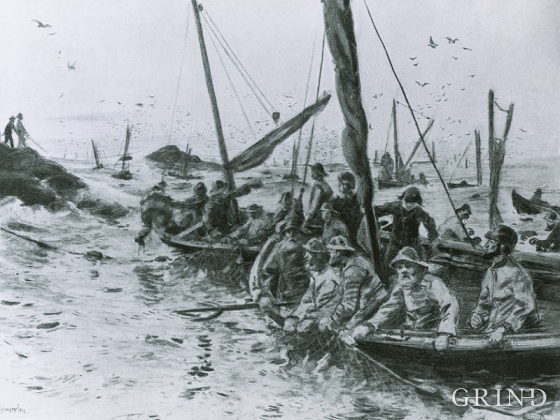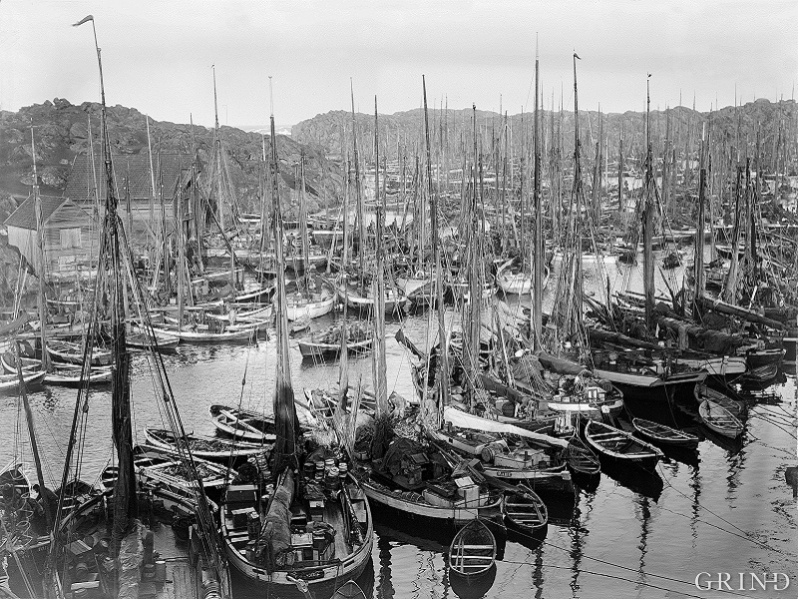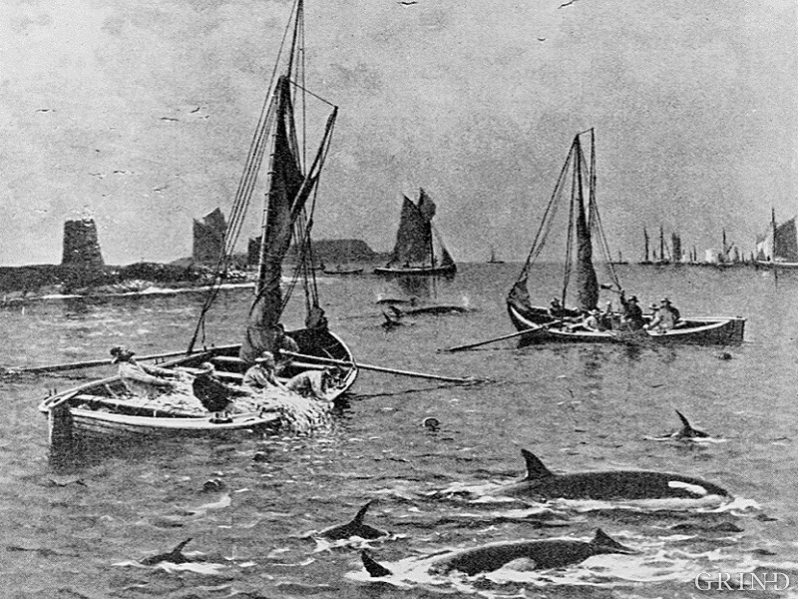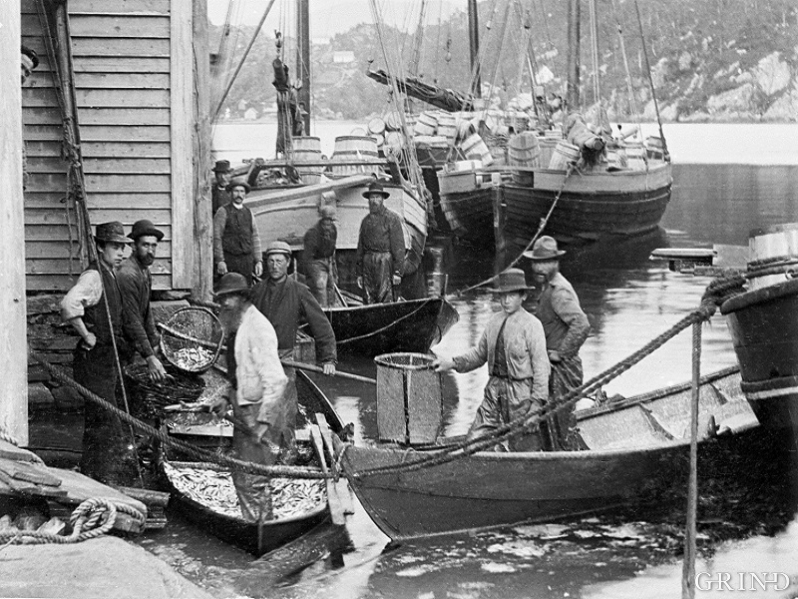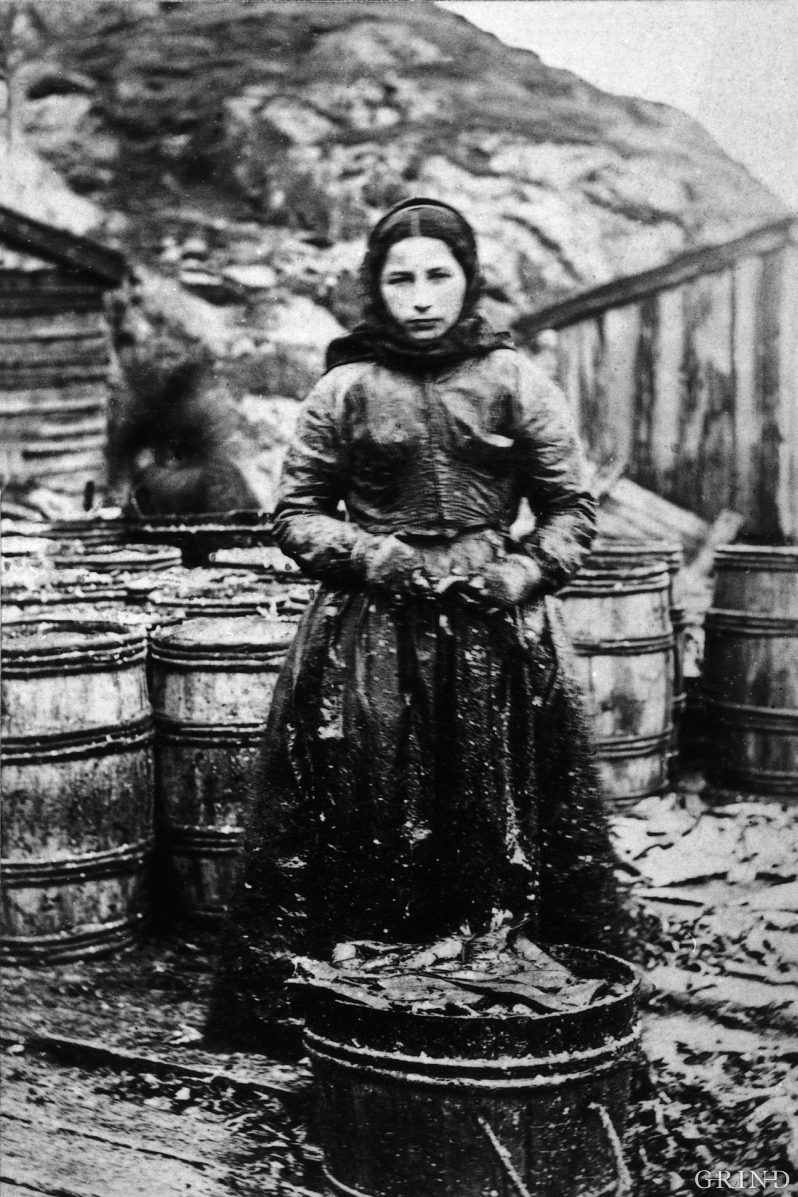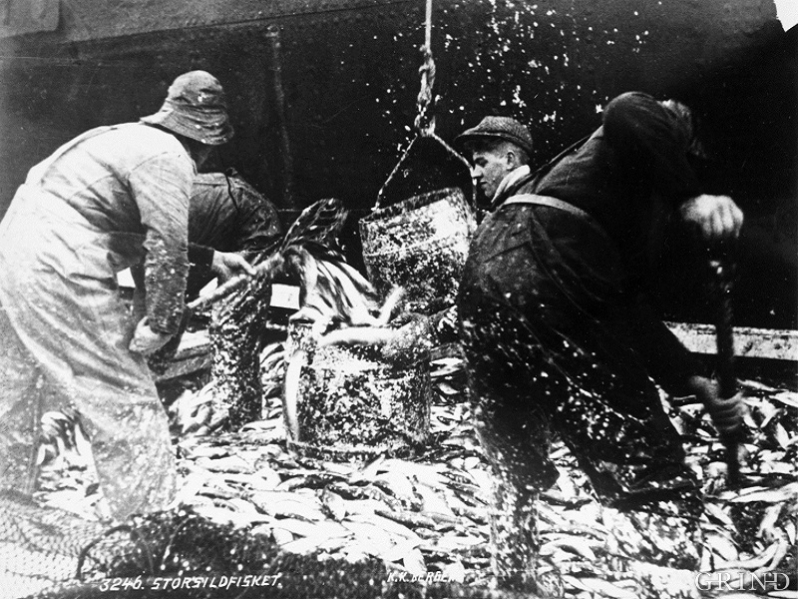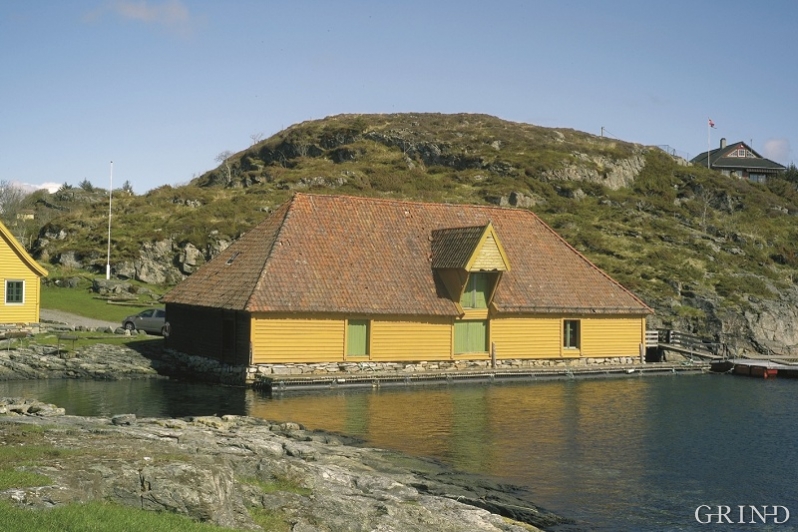Publisert: 19.05.2009 | Forfattar: Nils Kolle
Spring herring fishery at Espevær in the 1850s. drawing by G.Stenersen. (in private ownership).
THE GREAT HERRING ADVENTURE FROM THE 19TH CENTURY
In that year the adventure started at Christmas time. The scene is a rural district on the fjord in Sunnhordland, one winter’s day around 1850. We stand and gaze out over the sea, and suddenly the post boat comes into view around a headland: ”It was a six-oared boat with three men and they rowed so fast that they lay flat on the boards. In the prow stood an upright pole with a cloth or a piece of canvas, like a pennant. The course of the boat was making straight for the post opener’s house. ”Ahoy! Herring ahoy!” bellowed the shoemaker; suddenly he threw the board aside and leapt out in his woollen vest and his leather apron.
”So early, before Christmas. Now each and everyone of us is in a hurry. Now Nedrevaagen will have to manage their own seine nets. It was in this way that the boat with the strange pole at the front had wakened things up everywhere along the fjord. On farms and in open spaces folk came out of their houses and stood and looked with their hands over their eyes after it. There was no doubt. Ahoy! Herring Ahoy”
A couple of weeks later. We have moved out to the edge of the sea, and we meet the open sea against our gunwales – great, winter-grey swells. The trip goes southwards along Sletto. On the land side we hear the endless din of the surf. On the sea side are the skerries with great black cormorants which sit in rows, drying their wings.
”The closer we come towards Røvær, the denser the crowd of boats becomes, they sailed with oars under the sails - everyone was in a hurry. Figures in oilskins got up on to the thwart and shouted to each other about herring and herring sightings, about where and how many miles the herring were from land and where the shoals were expected now. Names such as Fejø, Veavaag, Ferkindstadøerne, Brandesund, Stolmen and Utsire whispered through the air in every rural dialect between Stavanger and Bergen. The clatter of a thousand tholepins died away, as they came nearer to the place where the common folk lay and waited on the shoals of herring. The noise was numbing, they got up speed, the boats raced with their oars – it meant getting first to the mooring places, the first to secure themselves a place to sleep in the rooms on the land”.
As the short winter day grows dark, we row into the harbour at Røvær. Here is a forest of small and large mastheads. The boats are lying close up to one another along the shore. The bigger ones are lying at anchor, the smaller ones have been dragged up on to the beach.
In the days that follow, the fishing station is steadily filling up with fishing boats and of supply boats and purchasing boats, “all slopping and splashing and rocking against each other in the wet and a grey restless sea, so close together that in many places in the harbour one could go over the boats and vessels like a bridge”.
And whenever the haze from the south-westerly showers lifted slightly, the islets are revealed full of people, looking for the sight of the herring. They stare outwards – over the leaden sea, the rain grey heavens, the scoured out-skerries.
Everyone is waiting on the herring.
Herring years and famine years
These descriptions are taken from the novel “Go On” by Jonas Lie. In the book the author conjures up a fascinating image of the great annual occurrence in the southwest Norway of the 19th century - the spring herring fishery. Every winter around New Year thousands of people would gather - for a few hectic weeks to harvest the mountain of herring which crashed into the land.
At the time when the events in the novel took place southwest Norway experienced one of the great herring periods. But it had not always been like this. The herring has always been an unreliable guest. The sources tell of a herring year and a famine year – or more properly herring periods and famine periods. For periods of 60 to 70 years the herring could be fairly regular along the coast, and then could suddenly disappear. For a generation or more the sea could be empty. Then suddenly one winter the herring were sighted again, and folk knew then that a prosperous time was in waiting.
We know of several such herring periods in recent centuries. During most of the 18th century the herring turned up regularly along our coast in the west of Norway. In 1784 it came to an end. For many years onwards the herring was absent from our coasts. But in the winter of 1808 they came back. This was in the hard, needy years of the Napoleonic Wars, and people thought that the herring had been sent by Higher Powers.
The spring herring period 1808-1870
From 1808 up until 1870 the winter spawning herring, or spring herring as it was known, was a regular visitor to southwest Norway. It was a rich fishery, especially in the generation around 1850. The majority of the catches were taken in the so-called southern district, or southern fishing grounds; the stretch of coast in Ryfylke and Sunnhordland. In the years around 1860 a greater share of the spring herring was caught in the northern district, or the northern field, from Sognesjøen in the south to Statlandet in the north.
For people in the rural districts of Hordaland the spring herring fisheries in the southern fishing grounds were most important, “southern fishery” as they said in Hardanger. The shoalings changed from year to year. Sometimes the majority came from the south and other times they came further north. In the rich herring years around 1850 the herring came on shore in the beginning of January, firstly at Kvitsøy-Skudenes. Then the bulk of the herring moved up along the coast, past Røvær and Haugesund, and further on to Sletto and Bømla Fjord to Espevær. It had usually taken about 5 or 6 weeks since the first shoalings at Skudenes. After this the herring went further north along the west side of Bømlo, past Geitung, Hiskjo and Brandasund where the fish ebbed out some time in March.
Towards the end of the 1850s this pattern began to change ever so slightly. The shoaling came later, and at the same time the volume of herring changed from one year to the other. These tendencies became more pronounced during the 1860s, while several new, disturbing features appeared. The old fears took hold of the fishermen. Was the spring herring about to disappear?
Things happened the way people had feared. In 1870 the real herring fisheries actually failed. Catches were further reduced during the 1870s. The nadir was reached in 1874 with only 3,000 barrels, as against 600,000 barrels in 1868. The spring herring fisheries on the Søra fishing grounds were over.
Labour migration
The rich and stable Søra fisheries create the basis for extensive labour migration or seasonal commuting. Every year at New Year thousands of menfolk went to sea. They went largely as a stream of people down the valleys and out the fjords to the fishing grounds on the edge of the sea. Just as the shoaling of the herring could vary from year to year, so could the stream of people change from year to year. Only the very few followed the herring all along the coast. Some people, especially those from Rogaland County and further south, could meet the herring at Skudenes and Utsira and follow them to Bokn and Karmsundet. Others, especially those from the rural districts of Hordaland County, turned up in Røvær and took part from Espevær to Brandasund, or further north. The most professional fishermen could follow the herring from when it came on shore in January, until it disappeared off out to sea, 8 to 10 weeks later.
We are not sure how many people took part in the southern fisheries in the rich years around 1850. The lighthouse director Arntzen, who observed the fisheries in 1849 was of the opinion that there must have been, all in all, 40,000 people hunting the herring that winter, that is fishermen, fish gutters, salters and the crew of the herring boats.
Many a rural district in both Rogaland County and Hordaland County and elsewhere were emptied of menfolk in the winter months. In Hardanger it was said that folk thought it was shameful if a healthy, able-bodied man was at home during the fisheries periods. It was as if he was marked as an inferior type of person.
“A gold mine for the nation”
In his five year report for 1881-1835 the County Commissioner in Søndre Bergenshus county wrote that the spring herring had become a true source of wealth for the county. “Many folk have been employed, not only for catching and salting herring, but also for building, partly for their own use and partly for sale, larger and smaller vessels for the purposes of the fisheries, as well as providing barrel staves and hoops, ropes,, nets and other fishing equipment, as well as transporting the herring to Bergen and Stavanger and to the inland parts of the county for processing”
The spring herring fishery became even more significant in the 1840s and the 1850s. The catches could reach 500,000 to 600,000 barrels of herring a year, and the activity provided work for many thousand willing hands, either directly in the fishery itself or through the different spreading effects which the fishery created. In addition came the export of herring. Up through the 19th century an increasingly larger proportion of the catches was salted and exported, mainly to the Baltic countries and the herring export employed a major foreign trading fleet. The spring herring fishery in western Norway was in truth “a gold mine for the nation” as it was declared in “Norway’s statistics” for 1848.
The division of work
The rich spring herring fishery, in a decisive manner, came to influence the west Norwegian landscape, economically, socially and culturally. In fact we can talk about a herring culture which stretched from the outermost coastal skerries and right up to the Hardanger plateau.
Rural societies adapted themselves to this source of wealth in different ways; through fishing, through coopering, and boat-building and through transport of trade in herring. With certain reservations we can say that this division into three parts corresponds to the outer, the middle and the inner districts of the County.
In the parishes along the seashore the menfolk took part mainly as fishermen. In the middle parishes the spreading effects of the fishery seemed to be more apparent; coopering, welding of metal hoops, boat building and ship-building. From these districts came much of the bark for impregnating the nets, seines and ropes. In the inner parishes we find the majority of the ship-builders; those that worked with herring transport, salting and trading in herring.
The reality was clearly not as schematic as portrayed above. Some of the folk along the sea worked with sailing for herring, and many a fjord dweller worked with nets or seines. In Strandebarm there were fishermen, boat-builders and freight people. Clear distinctions are not easy to find; forms of adaptation overlapped. However, in broad terms, this division into three provides the key to understanding some of the basic development features in the county through the 19th century.
In the following section we shall look at some of the effects of the different forms of adaptation.
The coastal districts
The landscape along the seashore is like a grey kingdom, naked and spare. But sometimes the glance can dwell upon a green cleft in all this greyness - mainly as a something to rest the eye on. It happens that the cleft opens up into a little valley with some topsoil and a few small farms - an oasis in an undulating stone desert. You perhaps wonder how folk can settle out here. How could they make a living?
People at the time did not think in this way. Quite the reverse and many people must have found that the districts along the sea gave good living conditions. The outer districts in fact experienced strong population growth in the first part of the 19th century, stronger than in the rest of the County. The growth was closely related to the flourishing spring herring fishery.
In the rural districts along the sea newcomers were, to a lesser extent, relegated to the lower orders, such as was the case in many Norwegian rural districts. During the 19th century. The problem of finding a basis for subsistence was solved, for the most part, by sub-dividing farms. Through a combination of agriculture and fisheries new people found a solution.
These development trends had distinct social consequences. The landed properties which in olden time were the most important foundation for social recognition and status were divided between many people. The fisheries in themselves must have had an egalitarian effect; success in fishing makes no class distinctions. Just as the country out by the sea had no great contrasts, so must the social landscape have been.
This development created specific cultural features. Typical for these are the strong laymen’s movements, and the many chapels which grew up on the west Norwegian coastal belt during the 19th century. These movements would hardly have had the same growth conditions in a more socially differentiated society. Otherwise the coast districts were characterised by mobility and change, conditions which often create a cultural vacuum, which in turn creates good conditions for spiritual movements.
The fjord districts
The grey kingdom lies behind us, and the landscape gradually becomes milder. The mountains stay in the background and let the pine forest have the opportunity to spread themselves out. And it is here that we find the basis for the way these districts adapted themselves to the wealth of the herring. The fishery created great demand for barrels, boats, vessels – products which needed good access to forest, especially pine forest. Welding of hoops and cooper work, boat-building and vessel building are characteristic features of the industrial structure in the middle rural districts during the 19th century.
The spring herring fisheries and the spreading effects they created, established the basis for the substantial population growth which took place in the middle districts. But here the new folk did not get hold of the land to the same degree as they did in the outer districts. The population growth took place to a greater degree within the lower social orders. In Strandebarm the number of crofters was increased by five times during the first half of the 19th century. But this is not so much the poor, humble folk one reads of in the farming novels. On the contrary it is a numerous group of folk - they forge hoops and work barrels, they build boats and vessels, they go herring fishing and they travel far - to North Norway and to the Baltic countries.
The hectic activity which the spring herring fishery and the maritime activities created, put its stamp on the people. Hans E.Kinck drew up a striking portrayal of the mentality in such a west Norwegian rural district. During his childhood he lived in Setesdal – a part of the country still living in the Middle Ages. In 1875, when Kinck was ten year old, the Kinck family moved to Strandebarm, where his father assumed the post as district doctor. The contrast to Setesdal was striking. In Strandebarm Kinck encountered a modern world, in an outward-looking West Norwegian fjord settlement. Here farmers were not only farmers, but seamen, fishermen and boat-builders. The encounter with Strandebarm was like being torn away from a dream: “The people’s wisdom and salty rationalism, their glibness, the impetuous rhythm of the language. I had come from the valley of the ballad to the home of rationalism – from the closed, sultry mysticism to the clear way of life and determination. It all felt like a powerful box on the ear.”
The inland districts
The fjord became narrower and the sides steeper; the mountains stoop more forwards. There is no room here for a belt of forest between the fjord and the mountain, as we saw further out. In some places the green strip of land along the fjord is interrupted by precipitous mountains which close off all traffic.
Here there is little material for building boats or vessels. On the other hand conditions were good for cargo transport. The fjord is long and traffic on land comes up against many hindrances. Really there was only one way out of these rural districts - out the fjord (and of course up the mountains). Maybe these natural peculiarities go to explain why the use of vessels gained a strong foothold so early in the inland districts.
When the spring herring fishing got under way in the beginning of the 19th century people in the inland districts quickly adapted themselves to the fisheries as freight merchants. They turned up in the fishing villages with proper vessels and the transported the herring to the salting works. Some plied for hire for the city merchants, others bought up the fresh herring and sold it to the salting works. The most enterprising could carry out purchasing and salting for their own account. In this way export could go in its own boat to Riga, Stettin and other Baltic cities. The return cargo was usually rye which they sold off in small quantities in their home districts. In this way local youths could turn themselves into enterprising and self-confident traders, and they moved not seldom to the young herring town of Haugesund.
The extensive cargo trade brought much rattling coin into the districts. It is not really by accident that the first savings banks started up in these typical shipping districts. Contemporary observers also seemed to think that welfare on the whole was best in the inland districts of the county.
The material surplus must have had clear cultural consequences. It looks as if the inland fjord districts quickly took up the new ideas. New equipment, new customs and new ways of doing things got their first foothold in the inland districts, and then they spread down the fjords. But at the same time these districts had or have strong feelings for the old cultural heritage. They had the financial surplus which was necessary to develop such attitudes.
Traffic to north Norway
When the spring herring began to fail in the 1860s, the shipping districts in Hardanger and Sunnhordland disposed of a great fleet which they directed into fisheries northwards along the coast into big herring fisheries, fat herring fisheries, winter cod fishing in the Lofoten Islands and spring cod fishing in Finnmark County. In he years up until the 1880s the purchasing trips to North Norway created wonderful times for these districts. There were tales that people were able to pay off a new boat with one trip to North Norway.
During the 1880s the trips to North Norway began to lose money. Many vessel owners were brought to their knees and had to sell. The losses continued during the 1890s, and cargo transport in Inner Hardanger also suffered. Many of the sloops were sold outside the fjord, to Jondal and Tysnes which in the years up until the First World War operated an extensive trade with North Norway. In the old ship-building districts people returned back to the soil. In Inner Hardanger fruit growing became the new area of concentration.
In our times
As the new century (the 20th) started up, the herring came back. In the years up to 1960 the west of Norway again experienced a new rich herring era. But the herring did not play nearly the same role as it had done in the previous century. The new herring era mainly employed only people in the districts on the sea, and in parts of the smaller districts.
The winter herring period from about 1900 to 1960 certainly did its bit to ensure that features from the old industrial patterns from the previous century continued to hold on into our own times. But today the picture is changing rapidly. The transition is greatest in the outer rural districts. The economic expansion of the past 10 to 15 years has mainly taken place in these very poor coastal districts. The traditional coastal fisherman is a dying race. Oil, aquaculture and commercial fishing has taken over and is in the process of transforming these societies.
In the middle districts one can still find the remains of the old industrial adaptations, but now in new forms. In the little community of Boga in Fusa municipality coopering developed into a small industry and there are still several people working in it. But it is not herring barrels that they make now. Now it is decorations in the form of small barrels, eight-oar boats and four-oar boats or impregnated tubs for use in gardens.
In Os and Strandebarm there are still some people building wooden boats. But the boats are not for fishing. Moe likely you will meet them on beautiful summer days, for example on the Oslo Fjord. At Fjellstrand there is still vessel-building, but now in aluminium. Twin-hulled speed boats have replaced the gracious sloops and galleys.
In the inner districts there is not much to remind one of the old seafaring and the herring culture. Times change. These districts, which in the 19th century were reckoned to be the best off in the county, are today in a sort of economic backwater. The GATT negotiations have put a damper on the fruit producers, and the there does not seem to be much of a future in the narrow strips of land along the fjord either. Some people are putting their faith in a bridge over the Hardangerfjord, and others talk of agro-tourism and more intensive exploitation of the Hardangervidda plateau.
It is difficult to forecast the future, as they say. But that the herring once more is going to create a new golden age in these districts – that is more than dubious.
- Boeck, A. (1871) Om Silden og Sildefiskerierne: navnlig om det norske Vaarsildfiske, 1, Indberetning til den kgl. norske Regjerings Departement for det Indre om foretagne praktisk-videnskabelige Undersøgelser. Christiania, B. M. Bentzen.
- Djupevåg, N. (1944) På fiske i sytti år. Stord.
- Fasting, K. (1960) Vintersild-soga: sild og samfunn gjennom hundre år. Sild og samfunn, nr. 1. Bergen, Noregs sildesalslag.
- Løberg, O. N. (1864) Norges Fiskerier. Kristiania, Bentzens Bogtrykkeri.
- Sjurseth, K., Weibust, K. & Wigum, S. (1961) Fiskarsoga for Hordaland. Bergen, Hordaland fiskarlag.
- Solhaug, T. (1976) De norske fiskeriers historie 1815-1880. Bergen, Universitetsforlaget.
- Sundt, E. (1976) På havet. Verker i utvalg, nr. 7. Oslo, Gyldendal.
- Vollan, O. (1971) Sildefisket gjennom tusen år. Norsk kulturarv, nr. 8. Oslo, Samlaget.

